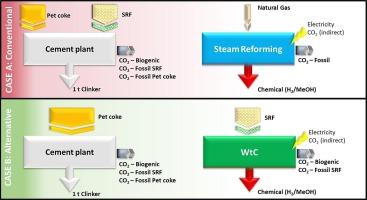Energy and environmental assessment of solid recovered fuels valorisation: Waste-to-Chemicals options vs co-combustion in cement plants
IF 7.1
2区 环境科学与生态学
Q1 ENGINEERING, ENVIRONMENTAL
引用次数: 0
Abstract
The increasing interest in Waste-to-Chemical (WtC) technologies operating with Solid Recovered Fuels (SRF) from non-recyclable plastic streams requires a quantitative analysis on the actual convenience of this alternative valorization pathway.
This study assesses SRF in selected WtC technologies for hydrogen and methanol production and compares it with the well-established practice of co-combustion in the cement industry. Two case studies are considered: the first one represents the current scenario where SRF is used in co-combustion for cement production meanwhile the chemical is produced by steam reforming; in the second scenario, the cement plant is fed with pet-coke only, leaving SRF as a feedstock for WtC.
WtC performance assessment has been carried out in Aspen Plus®, whereas cement production and steam reforming have been characterized based on literature information.
The two scenarios have been assessed for two SRF qualities (different LHV and biogenic content) calculating primary energy and fossil CO2 emissions.
The results show that SRF from plastic waste as a feedstock in WtC is less effective than its utilization in cement plant: when WtC technology for hydrogen production is adopted, additional 9.1% (SRF-1) and 8.6% (SRF-2) of energy consumption is estimated and 25.8% (SRF-1) and 24.1% (SRF-2) additional fossil CO2 is emitted with respect to the corresponding conventional cases (i.e., chemical from steam reforming and SRF burnt in the cement kiln). When considering methanol production, WtC technology requires 6.2% (SRF-1) and 5.6% (SRF-2) increase of primary energy and 30.2% (SRF-1) and 28.4% (SRF-2) additional fossil CO2 against the conventional cases.

固体回收燃料价值化的能源和环境评估:水泥厂的废物变化学品方案与共燃方案
随着人们对利用不可回收塑料流中的固体回收燃料(SRF)运行的 "废物变化学品"(WtC)技术的兴趣与日俱增,我们需要对这一替代价值化途径的实际便利性进行定量分析。本研究对选定的 WtC 技术中用于氢气和甲醇生产的 SRF 进行了评估,并将其与水泥行业成熟的共燃做法进行了比较。本研究考虑了两个案例研究:第一个案例代表了当前的情况,即在水泥生产中使用SRF进行协同燃烧,同时通过蒸汽转化生产化学品;在第二个案例中,水泥厂仅以石油焦为原料,将SRF作为WtC的原料。WtC性能评估是在Aspen Plus®中进行的,而水泥生产和蒸汽转化则是根据文献信息进行的。对两种 SRF 质量(不同的 LHV 和生物源含量)的两种方案进行了评估,计算了一次能源和化石 CO2 排放。当采用 WtC 技术制氢时,与相应的传统情况(即:蒸汽重整化学制氢和 SRF-2)相比,能耗估计分别增加了 9.1%(SRF-1)和 8.6%(SRF-2),二氧化碳化石排放量分别增加了 25.8%(SRF-1)和 24.1%(SRF-2)、与相应的常规情况(即蒸汽重整产生的化学品和在水泥窑中燃烧的 SRF)相比,额外排放了 25%(SRF-1)和 24.1%(SRF-2)的化石二氧化碳。考虑到甲醇生产,与传统情况相比,WtC 技术需要增加 6.2%(SRF-1)和 5.6%(SRF-2)的一次能源,以及 30.2%(SRF-1)和 28.4%(SRF-2)的额外化石二氧化碳。
本文章由计算机程序翻译,如有差异,请以英文原文为准。
求助全文
约1分钟内获得全文
求助全文
来源期刊

Waste management
环境科学-工程:环境
CiteScore
15.60
自引率
6.20%
发文量
492
审稿时长
39 days
期刊介绍:
Waste Management is devoted to the presentation and discussion of information on solid wastes,it covers the entire lifecycle of solid. wastes.
Scope:
Addresses solid wastes in both industrialized and economically developing countries
Covers various types of solid wastes, including:
Municipal (e.g., residential, institutional, commercial, light industrial)
Agricultural
Special (e.g., C and D, healthcare, household hazardous wastes, sewage sludge)
 求助内容:
求助内容: 应助结果提醒方式:
应助结果提醒方式:


